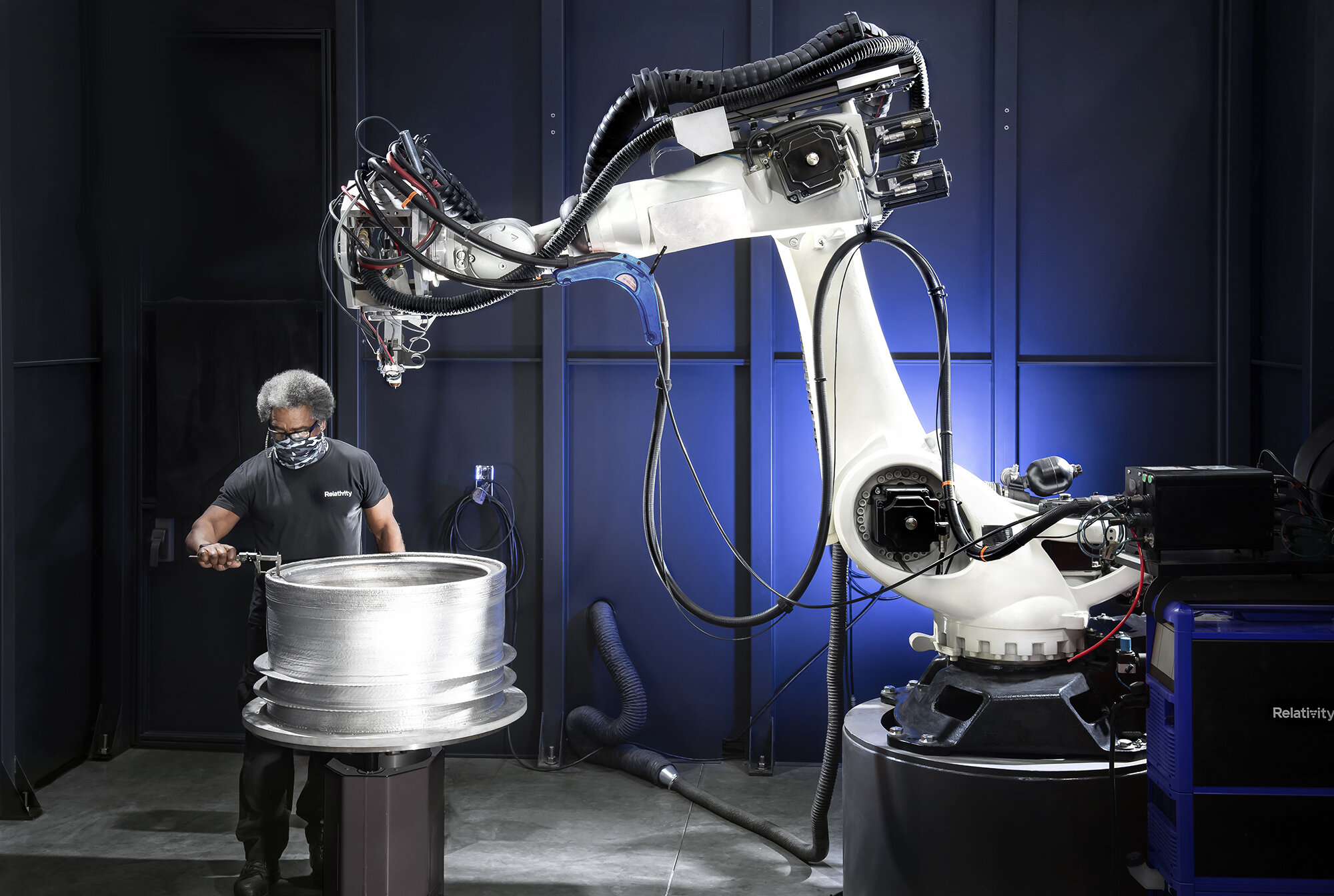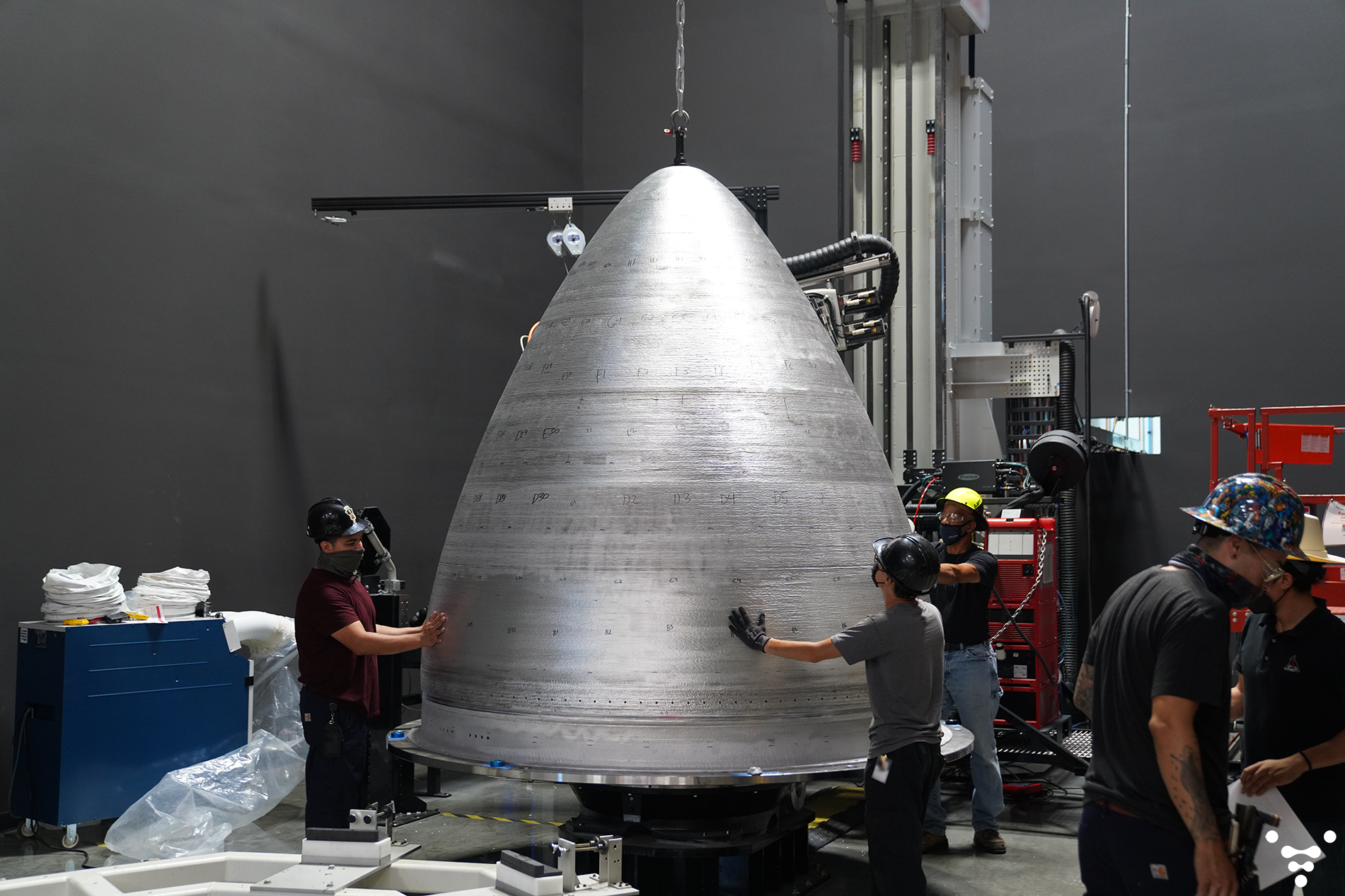Tim Ellis and Jordan Noon’s groundbreaking business Relativity Space has hit a major milestone with the complete testing of the first stage of its fully 3D printed Terran 1 rocket. As the company prepares for a demonstration launch in early 2022, the rocket’s Stage 1 successfully passed the hydro proof, cryogenic proof, and flight pressure testings at the company’s Long Beach, California facility. Once launched, the two-stage, small-lift launch vehicle will offer a three-meter fairing with a mass-to-orbit capability of up to 1,250 kg to low Earth orbit (LEO).
Under development since 2017, Terran 1 could become one of the most innovative products to emerge from the aerospace manufacturing industry since the dawn of privatization of space 20 years ago. This is mainly because Relativity uses two types of 3D printing to produce over 90% of the dry mass of Terran 1. Its large format, proprietary 3D printing process, Stargate, can create primary and secondary structures for Terran 1 from a proprietary aluminum alloy – with printing, inspection, and the little post-processing required occurring all in a single print cell.
Stargate can currently print structures up to 3.4 meters (11 feet) diameter by 7.6 meters (25 feet) tall – the world’s largest metallic printed parts. Capable of vertically integrating artificial intelligence, robotics, and patented autonomous manufacturing technology, Relativity’s 3D printing platform can build Terran 1, from raw material to flight in less than 60 days, making the manufacturing technology extremely attractive to customers’ evolving needs. Relativity also uses direct-to-metal laser sintering (DMLS) to produce geometrically small, high fidelity components for Terran 1. Recently, the company released a video of the 3D printer creating a unique shape, a nose cone for Terran 1, using zero fixed tooling.
The Terran 1 first stage assembly consists of three main components: the thrust structure, the Stage 1 tank, and the interstage. The tanks share a common dome and airframe that is integrally printed as monolithic sections, where a horizontal welding process integrates Stage 1 segments together to achieve the final stage structure. A transfer tube carries liquid oxygen (LOX) through the center of the liquid natural gas (LNG) tank to the engines. Nine Aeon-1 engines power the first stage for a total thrust of up to 207,000 lbf at liftoff.
With the new Stage 1 testing complete, Relativity’s rocket has reached a critical pre-launch phase, especially considering that Terran 1’s Stage 2 passed the cryogenic pressure-proof and hydro-mechanical buckling test one month ago on the company’s structural test stand. Focusing on the future of launch vehicle development, Relativity revealed that in only 12 months, they managed to finalize Terran 1’s architecture, developed a brand new engine, upgraded its material, and grew from 150 employees to more than 500.
Terran 1’s demonstration launch is now set for early 2022 from Launch Complex 16 (LC-16) at Cape Canaveral Space Force Station in Florida. The launch site will support initial test flights of Terran 1 and subsequent customer flights, supporting low- and mid-inclination orbits. As part of the preparations for the momentous launch, Relativity engineers recently completed the maiden lift of the strongback at the LC-16. This rigid structure will provide support for the launch vehicle. In addition, this exciting milestone involved electrical utilities being taken to the launch site and commissioned, activating a hydraulic lift system, and fabricating and installing the pad deck and launch table.
Just two days before announcing the complete testing of Stage 1, Reuters reported that the Federal Aviation Administration (FAA) was proposing to issue a vehicle operator license to the venture-backed startup after completing an environmental review. According to the news agency, the U.S. Air Force prepared the assessment with the FAA as a cooperating agency and stated that Relativity must also meet agency safety, risk, and financial responsibility requirements before a license can be issued.

Relativity Space develops its own in-house 3D printing technology. Image courtesy of Relativity Space.
Currently valued at $4.2 billion, Relativity is the second-most valuable privately-held space firm behind Elon Musk’s SpaceX. Reaching that valuation had a lot to do with the recent $650 million funds raised in a Series E round, raising the total funds to $1.3 billion. At this rate, we can expect the private firm to continue pioneering the “factory of the future” as it develops in-house 3D printing technologies capable of building entire rockets and offering a radically simplified supply chain that will reduce launch vehicle part count by 100. As Relativity gets closer to the countdown, we can’t wait to finally witness the world’s first 3D printed Terran 1 rocket awaits for take-off on the pad at Cape Canaveral.
Subscribe to Our Email Newsletter
Stay up-to-date on all the latest news from the 3D printing industry and receive information and offers from third party vendors.
You May Also Like
Precision at the Microscale: UK Researchers Advance Medical Devices with BMF’s 3D Printing Tech
University of Nottingham researchers are using Boston Micro Fabrication‘s (BMF) 3D printing technology to develop medical devices that improve compatibility with human tissue. Funded by a UK grant, this project...
3D Printing Webinar and Event Roundup: April 21, 2024
It’s another busy week of webinars and events, starting with Hannover Messe in Germany and continuing with Metalcasting Congress, Chinaplas, TechBlick’s Innovation Festival, and more. Stratasys continues its advanced training...
3D Printing Webinar and Event Roundup: March 17, 2024
It’s another busy week of webinars and events, including SALMED 2024 and AM Forum in Berlin. Stratasys continues its in-person training and is offering two webinars, ASTM is holding a...
3D Printed Micro Antenna is 15% Smaller and 6X Lighter
Horizon Microtechnologies has achieved success in creating a high-frequency D-Band horn antenna through micro 3D printing. However, this achievement did not rely solely on 3D printing; it involved a combination...






























